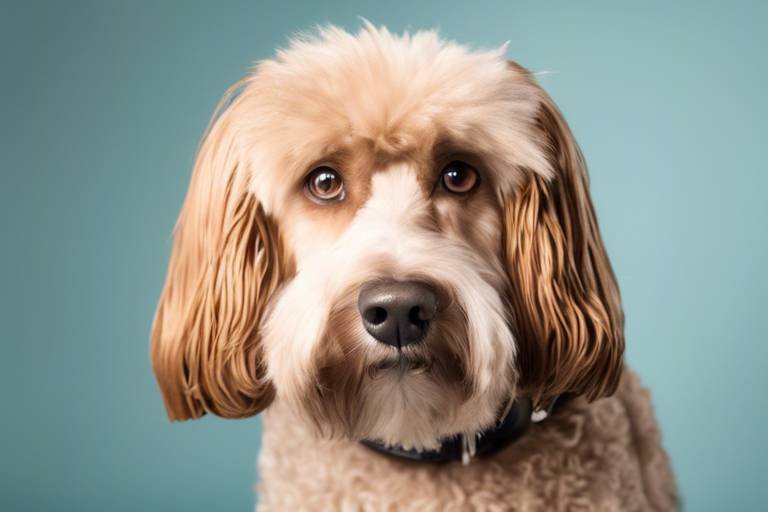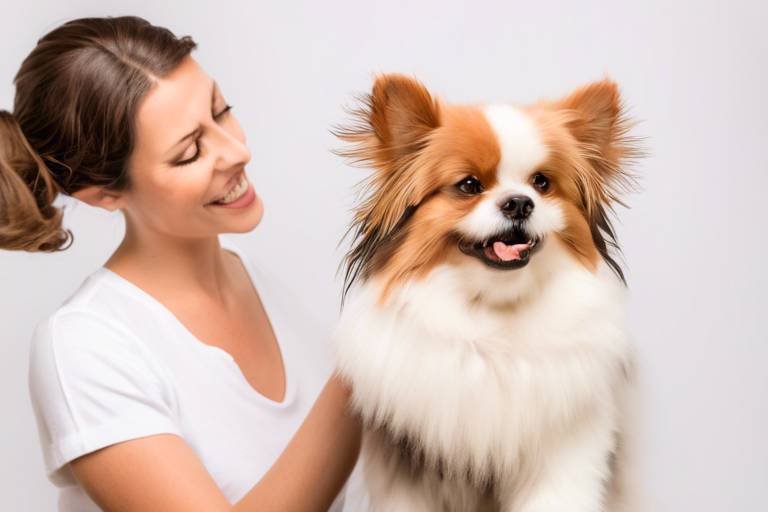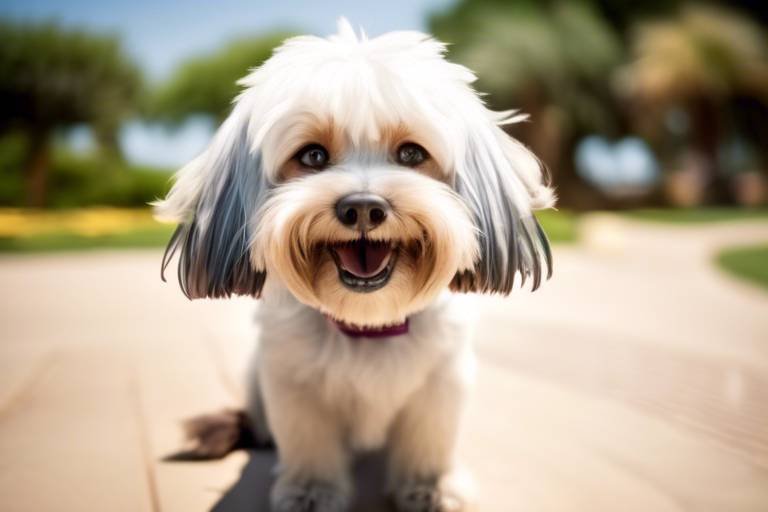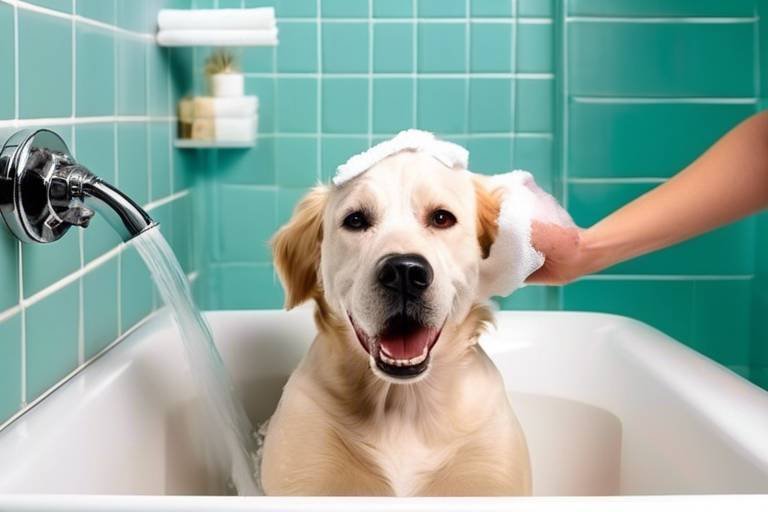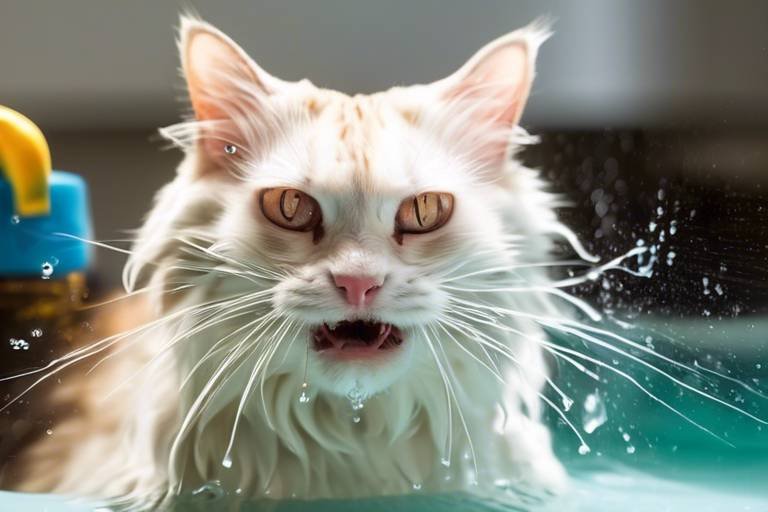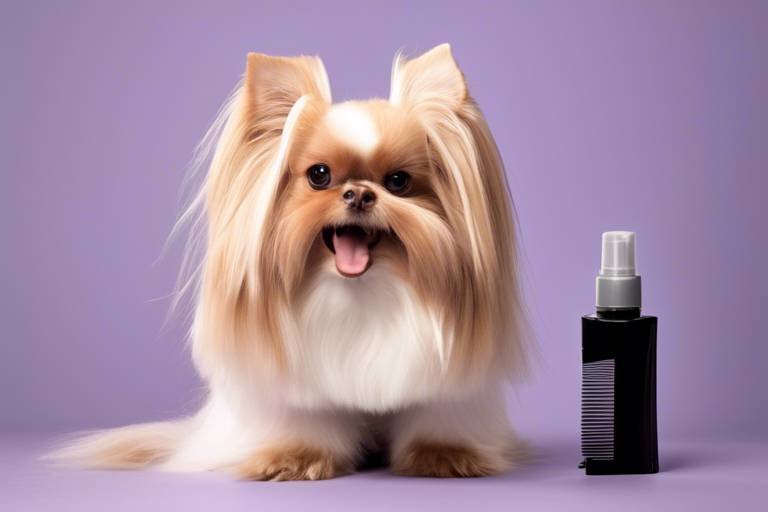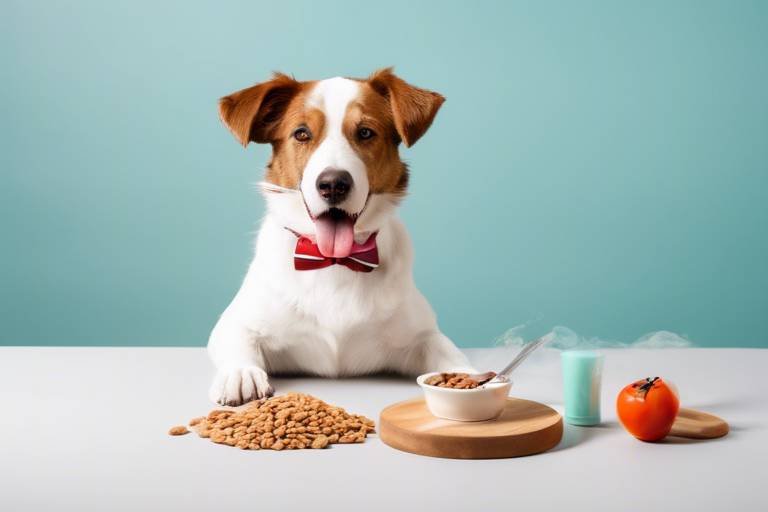How to Address Common Grooming Anxiety in Pets
The world of pet grooming can be a daunting experience, not just for our furry companions but for us as well. Imagine this: you have a beautiful dog or cat, and you know they need grooming, but the very thought of it sends shivers down your spine. Why? Because you know your pet experiences grooming anxiety. This article explores effective strategies to help pet owners manage and alleviate grooming anxiety in their furry companions, ensuring a more comfortable and enjoyable grooming experience for both pets and their owners.
Grooming anxiety in pets can stem from various factors, including past experiences and sensitivity to touch. Just like humans, pets can have traumatic memories that trigger their anxiety during grooming sessions. Recognizing the signs and understanding the root causes is crucial for effective intervention. For instance, if a pet was once mishandled during a grooming session, they might associate grooming tools with pain or discomfort. This understanding can help you approach the situation with empathy and care.
Identifying the signs of grooming anxiety is essential for pet owners. Common symptoms include trembling, hiding, and aggressive behavior, which can indicate a pet's discomfort during grooming sessions. Being observant and aware of these signs can make a world of difference in how you approach grooming. Here are some signs to watch out for:
Physical symptoms of grooming anxiety may include excessive panting, drooling, and attempts to escape. Recognizing these signs can help owners address their pet's anxiety more effectively. For example, if your pet is panting heavily or trying to flee, it’s a clear indication that they’re not comfortable. Understanding these physical cues allows you to take a step back and reassess your grooming strategy.
Behavioral changes such as aggression or withdrawal during grooming can signal anxiety. If your usually friendly pet suddenly becomes aggressive or tries to hide, it may be due to grooming anxiety. Understanding these changes allows owners to adapt their approach and create a more positive environment. Instead of forcing the grooming process, consider taking a break and trying again later when your pet seems calmer.
Vocalizations like whining or growling during grooming can indicate distress. Paying attention to these sounds can help owners identify and address their pet's anxiety levels effectively. If your pet vocalizes their discomfort, it’s crucial to listen and respond appropriately, perhaps by soothing them or stopping the grooming session altogether.
Emotional factors such as fear and stress contribute significantly to grooming anxiety. Understanding these emotions is key to developing strategies that promote a sense of security for pets. Just like humans, pets thrive in environments where they feel safe and loved. By creating a nurturing atmosphere, you can help your pet overcome their grooming fears.
Preparation is vital in reducing grooming anxiety. Establishing a calm environment, using familiar tools, and creating positive associations can help pets feel more comfortable during grooming sessions. Think of it as setting the stage for a great performance; the more comfortable your pet feels, the better the outcome will be.
Designing a safe and comforting space for grooming can alleviate anxiety. Using familiar bedding and toys can help pets feel secure and relaxed during the process. Imagine a cozy corner filled with their favorite blanket and toys; this can transform the grooming experience from a scary ordeal to a comfortable routine.
Incorporating positive reinforcement techniques, such as treats and praise, can encourage pets to associate grooming with positive experiences, ultimately reducing anxiety over time. For example, rewarding your pet with a treat after a successful grooming session can create a positive feedback loop that makes them look forward to the next session.
Selecting appropriate grooming tools is essential for minimizing discomfort. Understanding your pet's coat type and sensitivity can help you choose the right brushes and clippers for a more pleasant experience. Just as you wouldn’t use a sledgehammer to crack a nut, you shouldn’t use harsh tools on a sensitive pet.
For pets with sensitive skin or anxiety, using gentle grooming tools can make a significant difference. Opting for soft brushes and quiet clippers can help ease their discomfort. It’s all about finding the right balance between effective grooming and ensuring your pet feels safe and secure.
Establishing regular grooming habits can help pets acclimate to the process, reducing anxiety over time. Consistency is key to helping pets feel more comfortable with grooming sessions. Think of it like a workout routine; the more you practice, the easier it becomes. Regular grooming can help your pet view the process as a normal part of their life rather than a stressful event.
In some cases, professional help may be necessary to address severe grooming anxiety. Groomers and veterinarians can provide valuable insights and techniques tailored to your pet's needs. Sometimes, a fresh perspective can make all the difference.
Choosing a groomer experienced in handling anxious pets can make a significant difference. Researching and asking for recommendations can help you find the right fit for your furry friend. A groomer who understands your pet's anxiety can adapt their techniques to create a more positive experience.
Behavioral training can be beneficial for pets with extreme grooming anxiety. Consulting with a professional trainer can provide tailored strategies to help alleviate anxiety during grooming. This could involve desensitization techniques that gradually introduce your pet to grooming tools and processes in a safe and controlled manner.
Q: How can I tell if my pet has grooming anxiety?
A: Look for signs such as trembling, hiding, excessive panting, or vocalizations like whining and growling. These behaviors often indicate discomfort or fear during grooming.
Q: What should I do if my pet becomes aggressive during grooming?
A: If your pet shows aggression, it’s essential to stop grooming immediately. Take a break, and try to create a calmer environment before attempting again.
Q: Are there specific tools that are better for anxious pets?
A: Yes, using soft brushes and quiet clippers can help minimize discomfort for sensitive pets. Always choose tools that are appropriate for your pet's coat type and sensitivity.
Q: How often should I groom my pet?
A: Regular grooming schedules depend on the breed and coat type of your pet. Generally, establishing a routine can help your pet become more comfortable with the process.

Understanding Grooming Anxiety
This article explores effective strategies to help pet owners manage and alleviate grooming anxiety in their furry companions, ensuring a more comfortable and enjoyable grooming experience for both pets and their owners.
Grooming anxiety in pets can be a perplexing issue for many pet owners. It’s essential to realize that this anxiety can stem from a variety of factors, including past experiences with grooming, sensitivity to touch, or even the unfamiliarity of the grooming environment. Just like humans, pets can develop fears based on their experiences. For instance, a dog that has had a negative experience at the groomer may associate grooming with fear and discomfort. This understanding is crucial for effective intervention.
Recognizing the signs of grooming anxiety is the first step toward helping your pet. Some pets may exhibit obvious signs, while others may show subtle changes in behavior. It's like deciphering a secret code; once you know what to look for, you'll be able to respond appropriately. Common signs include trembling, hiding, or even aggressive behavior during grooming sessions. Understanding these signs can help you create a more positive experience for your pet.
Additionally, emotional factors play a significant role in grooming anxiety. Pets are sensitive creatures; they can pick up on their owners' emotions and the overall atmosphere of the grooming environment. If you’re feeling anxious about grooming, your pet may feel that energy too. It’s a two-way street. Therefore, creating a calm and reassuring atmosphere is key. Think of it as setting the stage for a performance; the right environment can lead to a much better outcome.
In summary, understanding grooming anxiety involves recognizing its various causes, identifying the signs, and acknowledging the emotional factors at play. By being attuned to your pet's feelings and behaviors, you can take significant steps toward alleviating their anxiety and making grooming a more enjoyable experience for both of you.
Identifying the signs of grooming anxiety is essential for pet owners. Common symptoms include trembling, hiding, and aggressive behavior, which can indicate a pet's discomfort during grooming sessions.
Physical symptoms of grooming anxiety may include excessive panting, drooling, and attempts to escape. Recognizing these signs can help owners address their pet's anxiety more effectively.
Behavioral changes such as aggression or withdrawal during grooming can signal anxiety. Understanding these changes allows owners to adapt their approach and create a more positive environment.
Vocalizations like whining or growling during grooming can indicate distress. Paying attention to these sounds can help owners identify and address their pet's anxiety levels effectively.
Emotional factors such as fear and stress contribute significantly to grooming anxiety. Understanding these emotions is key to developing strategies that promote a sense of security for pets.
Preparation is vital in reducing grooming anxiety. Establishing a calm environment, using familiar tools, and creating positive associations can help pets feel more comfortable during grooming sessions.
Designing a safe and comforting space for grooming can alleviate anxiety. Using familiar bedding and toys can help pets feel secure and relaxed during the process.
Incorporating positive reinforcement techniques, such as treats and praise, can encourage pets to associate grooming with positive experiences, ultimately reducing anxiety over time.
Selecting appropriate grooming tools is essential for minimizing discomfort. Understanding your pet's coat type and sensitivity can help you choose the right brushes and clippers for a more pleasant experience.
For pets with sensitive skin or anxiety, using gentle grooming tools can make a significant difference. Opting for soft brushes and quiet clippers can help ease their discomfort.
Establishing regular grooming habits can help pets acclimate to the process, reducing anxiety over time. Consistency is key to helping pets feel more comfortable with grooming sessions.
In some cases, professional help may be necessary to address severe grooming anxiety. Groomers and veterinarians can provide valuable insights and techniques tailored to your pet's needs.
Choosing a groomer experienced in handling anxious pets can make a significant difference. Researching and asking for recommendations can help you find the right fit for your furry friend.
Behavioral training can be beneficial for pets with extreme grooming anxiety. Consulting with a professional trainer can provide tailored strategies to help alleviate anxiety during grooming.
Q: What are the common signs of grooming anxiety in pets?
A: Common signs include trembling, hiding, excessive panting, drooling, and aggressive behavior. Emotional signs can include whining or growling during grooming sessions.
Q: How can I create a positive grooming experience for my pet?
A: You can create a positive experience by establishing a calm environment, using familiar tools, and incorporating positive reinforcement techniques like treats and praise.
Q: When should I seek professional help for my pet's grooming anxiety?
A: If your pet exhibits severe anxiety that affects their behavior during grooming, it may be time to consult a professional groomer or a veterinarian for tailored advice.
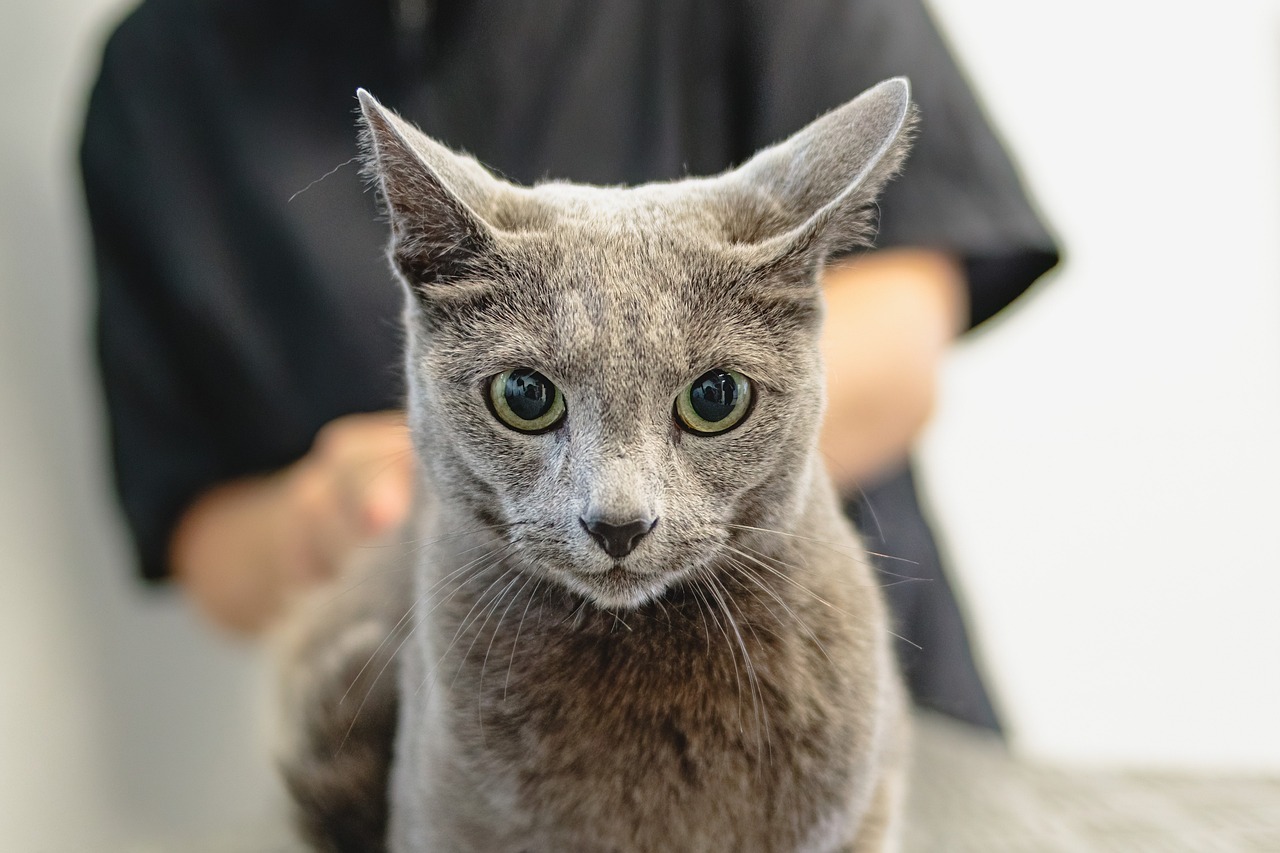
Signs of Grooming Anxiety
Recognizing the signs of grooming anxiety in your pet is crucial for providing them with the comfort they deserve. Just like humans, pets can experience stress and discomfort, especially during grooming sessions. It's essential to be observant and aware of their behavior, as these signs can vary from one furry friend to another. Some pets may express their anxiety through physical signs, while others may show behavioral changes or vocalizations. Understanding these signs can help you tailor your approach to make grooming a more positive experience.
Common symptoms of grooming anxiety include:
- Trembling: If your pet starts shaking or trembling during grooming, it may indicate fear or anxiety.
- Hiding: Pets that seek refuge under furniture or in a corner are likely feeling overwhelmed.
- Aggressive behavior: Growling, snapping, or biting can be a pet's way of expressing discomfort or fear.
It's important to note that these signs can manifest physically as well. For instance, excessive panting and drooling often accompany anxiety. If your pet is trying to escape or is constantly fidgeting, these behaviors signal that they are not comfortable with the grooming process. Addressing these physical symptoms is crucial for alleviating their anxiety.
Physical symptoms of grooming anxiety may include:
- Excessive panting: This can indicate that your pet is stressed and struggling to cope with the grooming experience.
- Drooling: An increase in drooling can be a sign of anxiety, as pets may salivate more when they are nervous.
- Attempts to escape: If your pet is trying to jump off the table or run away, it’s a clear indication that they are feeling anxious.
Behavioral changes are another critical aspect to consider. If your pet suddenly becomes aggressive or withdraws during grooming, it’s a sure sign that something is amiss. These changes can be subtle, so it’s essential to be attentive. For example, if your pet usually enjoys being brushed but suddenly resists, this shift in behavior may indicate anxiety. Understanding these changes allows you to adapt your approach, creating a more positive and supportive environment for your pet.
Vocalizations can also provide insight into your pet's emotional state during grooming. Sounds like whining, growling, or even barking can indicate distress. These vocal cues are their way of communicating discomfort, and ignoring them can exacerbate their anxiety. By paying attention to these sounds, you can better gauge your pet's anxiety levels and take steps to alleviate their stress.
Emotional factors such as fear and stress play a significant role in grooming anxiety. Pets are sensitive creatures, and their feelings can be influenced by past experiences, their environment, and even the grooming tools being used. Understanding these emotions is key to developing strategies that promote a sense of security for your pets. For instance, if a pet had a negative experience with grooming in the past, it may carry that fear into future sessions. By creating a calm environment and using familiar tools, you can help ease their anxiety over time.
Q: How can I tell if my pet has grooming anxiety?
A: Look for signs such as trembling, hiding, aggressive behavior, excessive panting, drooling, and vocalizations like whining or growling.
Q: What should I do if my pet shows signs of grooming anxiety?
A: Start by creating a calm environment, using familiar tools, and incorporating positive reinforcement techniques to help your pet associate grooming with positive experiences.
Q: Is it necessary to seek professional help for grooming anxiety?
A: If your pet's anxiety is severe, it may be beneficial to consult with a professional groomer or a veterinarian who can provide tailored strategies to address the issue.
Physical Symptoms
This article explores effective strategies to help pet owners manage and alleviate grooming anxiety in their furry companions, ensuring a more comfortable and enjoyable grooming experience for both pets and their owners.
Grooming anxiety in pets can stem from various factors, including past experiences and sensitivity to touch. Recognizing the signs and understanding the root causes is crucial for effective intervention.
Identifying the signs of grooming anxiety is essential for pet owners. Common symptoms include trembling, hiding, and aggressive behavior, which can indicate a pet's discomfort during grooming sessions.
Physical symptoms of grooming anxiety can manifest in several noticeable ways. For instance, you might observe your pet exhibiting excessive panting, which is a clear indicator that they are feeling stressed or uncomfortable. Another common symptom is drooling; if your furry friend is producing more saliva than usual, it’s a sign that they might be anxious. Additionally, pets may attempt to escape the grooming situation, which could involve trying to jump off the grooming table or hiding under furniture.
Understanding these physical symptoms is crucial for pet owners. Recognizing them early allows for timely intervention. Here’s a quick overview of some physical symptoms to watch for:
- Panting: Rapid breathing can indicate stress.
- Drooling: Increased saliva production is often a sign of anxiety.
- Attempts to escape: If your pet is trying to flee, they are likely uncomfortable.
Moreover, these symptoms can sometimes escalate. For example, if a pet is excessively panting and drooling, it might lead to more severe reactions such as biting or scratching during grooming. This not only makes grooming a challenge but can also result in injuries to both the pet and the groomer. Thus, being vigilant about these signs can help you create a safer grooming environment.
Behavioral changes such as aggression or withdrawal during grooming can signal anxiety. Understanding these changes allows owners to adapt their approach and create a more positive environment.
Vocalizations like whining or growling during grooming can indicate distress. Paying attention to these sounds can help owners identify and address their pet's anxiety levels effectively.
Emotional factors such as fear and stress contribute significantly to grooming anxiety. Understanding these emotions is key to developing strategies that promote a sense of security for pets.
Preparation is vital in reducing grooming anxiety. Establishing a calm environment, using familiar tools, and creating positive associations can help pets feel more comfortable during grooming sessions.
Designing a safe and comforting space for grooming can alleviate anxiety. Using familiar bedding and toys can help pets feel secure and relaxed during the process.
Incorporating positive reinforcement techniques, such as treats and praise, can encourage pets to associate grooming with positive experiences, ultimately reducing anxiety over time.
Selecting appropriate grooming tools is essential for minimizing discomfort. Understanding your pet's coat type and sensitivity can help you choose the right brushes and clippers for a more pleasant experience.
For pets with sensitive skin or anxiety, using gentle grooming tools can make a significant difference. Opting for soft brushes and quiet clippers can help ease their discomfort.
Establishing regular grooming habits can help pets acclimate to the process, reducing anxiety over time. Consistency is key to helping pets feel more comfortable with grooming sessions.
In some cases, professional help may be necessary to address severe grooming anxiety. Groomers and veterinarians can provide valuable insights and techniques tailored to your pet's needs.
Choosing a groomer experienced in handling anxious pets can make a significant difference. Researching and asking for recommendations can help you find the right fit for your furry friend.
Behavioral training can be beneficial for pets with extreme grooming anxiety. Consulting with a professional trainer can provide tailored strategies to help alleviate anxiety during grooming.
Q: How can I tell if my pet is anxious during grooming?
A: Look for signs such as excessive panting, drooling, hiding, or attempts to escape. Vocalizations like whining or growling can also indicate distress.
Q: What can I do to help my pet feel more comfortable during grooming?
A: Create a safe space, use familiar tools, and incorporate positive reinforcement techniques like treats and praise to build positive associations with grooming.
Q: Should I seek professional help for my pet's grooming anxiety?
A: If your pet's anxiety is severe, consulting a professional groomer or a veterinarian can provide tailored strategies and support.
Behavioral Changes
When it comes to grooming anxiety in pets, can be some of the most telling signs of distress. Have you ever noticed your furry friend suddenly becoming more aggressive or withdrawn during grooming sessions? These changes are not just quirks; they are their way of communicating discomfort or fear. For instance, a pet that typically enjoys cuddling might start to shy away or hide when you bring out the grooming tools. This shift can be alarming and often requires immediate attention.
Understanding these behavioral changes is crucial for pet owners. You might find that your once-enthusiastic pup now cowers in the corner or your cat, who usually loves being petted, suddenly swipes at your hand when you try to brush her fur. These reactions can stem from a variety of factors, including past negative experiences with grooming, sensitivity to touch, or even the sounds of grooming tools. By recognizing these signs, you can adapt your approach to create a more positive environment for your pet.
It's essential to note that behavioral changes can manifest in several ways, such as:
- Aggression: Pets may growl, bite, or scratch when they feel threatened or anxious.
- Withdrawal: Some pets may attempt to escape or hide, indicating they feel overwhelmed.
- Restlessness: Pacing or excessive movement can indicate a pet's inability to relax during grooming.
Recognizing these signs early on can make a significant difference in how you approach grooming. Instead of forcing your pet into a situation that makes them uncomfortable, consider taking a step back. Perhaps start with shorter grooming sessions, gradually increasing the time as your pet becomes more accustomed to the process. This gradual exposure can help them build trust and reduce anxiety over time.
Moreover, creating a soothing atmosphere can also help mitigate these behavioral changes. Play soft music, use calming scents, or even engage in some gentle petting before you start grooming. By doing so, you not only create a more relaxed environment but also reinforce positive associations with grooming. Remember, patience is key. Just like humans, pets need time to adjust to new experiences, especially if they are linked to anxiety.
In summary, being attentive to your pet's behavioral changes during grooming can help you address their anxiety effectively. By understanding their signals and adapting your grooming techniques, you can transform what might be a stressful experience into a more enjoyable one for both you and your furry companion.
- What causes grooming anxiety in pets? Grooming anxiety can arise from past traumatic experiences, sensitivity to touch, or even the sounds of grooming tools.
- How can I tell if my pet is anxious during grooming? Signs of anxiety include trembling, hiding, aggressive behavior, excessive panting, and vocalizations like whining or growling.
- What can I do to help my pet feel more comfortable during grooming? Establish a calm environment, use familiar tools, and incorporate positive reinforcement techniques, such as treats and praise.
- When should I seek professional help for my pet's grooming anxiety? If your pet's anxiety is severe and does not improve with home strategies, consider consulting a groomer or veterinarian experienced in handling anxious animals.
Vocalizations
When it comes to grooming anxiety in pets, can be one of the most telling signs of discomfort or distress. If your furry friend starts whining, growling, or even yelping during grooming sessions, it's crucial to pay attention to these sounds. Just like humans, pets express their feelings, and vocalizations can serve as a window into their emotional state. Imagine a child who is scared of the dark; their cries are a clear indication that something is wrong. Similarly, your pet’s vocalizations can signify that they are feeling anxious or threatened.
For instance, a soft whine might indicate mild discomfort, while a low growl could signal that your pet is feeling threatened or defensive. Understanding the context of these sounds is essential. Are they vocalizing when you reach for the grooming tools, or do they become more vocal once the process begins? By observing their behavior closely, you can better gauge their anxiety levels and adjust your approach accordingly.
It's also worth noting that some pets may vocalize more than others. Breeds known for being more vocal, such as Beagles or Chihuahuas, might express their anxiety through sound more readily than quieter breeds. This doesn't mean that quieter pets aren't experiencing anxiety; they may just express it differently. To help you better understand the types of vocalizations your pet might exhibit during grooming, consider the following table:
| Vocalization Type | Possible Interpretation |
|---|---|
| Whining | Mild discomfort or anxiety |
| Growling | Feeling threatened or defensive |
| Barking | Excitement or stress |
| Yelping | Pain or severe distress |
By recognizing these vocal cues, you can create a more supportive grooming environment. For example, if your pet starts whining, it may be time to take a break and offer some comforting words or a treat. This not only helps to ease their anxiety but also reinforces a positive association with grooming. Remember, the goal is to make grooming a stress-free experience for both you and your pet. So, next time you hear those vocalizations, take a moment to listen and respond with compassion.
- What should I do if my pet growls during grooming?
It's essential to stop grooming and assess the situation. Give your pet some space and try to identify what might be causing their discomfort. Gradually reintroduce grooming when they seem calmer. - Can vocalizations indicate pain?
Yes, vocalizations like yelping can indicate that your pet is in pain. If you suspect this, consult your veterinarian for a thorough check-up. - How can I help my pet feel more comfortable during grooming?
Consider using positive reinforcement techniques such as treats and praise. Creating a calm environment and using gentle grooming tools can also help ease their anxiety.
Emotional Factors
When it comes to grooming anxiety in pets, emotional factors play a crucial role. Just like humans, our furry friends can experience a range of emotions, and these feelings can significantly impact their behavior during grooming sessions. For instance, many pets may have had negative past experiences related to grooming, such as painful haircuts or rough handling. This history can lead to an overwhelming sense of fear or stress whenever they see grooming tools or are placed in a grooming environment.
It's essential to recognize that pets are not just physical beings; they have emotional lives filled with feelings of fear, anxiety, and stress. When a pet feels threatened or uncomfortable, their instinct is often to react with avoidance or aggression. Understanding these emotional triggers can help owners create a more supportive and calming atmosphere. For example, if a dog has had a traumatic experience with a particular grooming tool, it might be beneficial to avoid that tool and find alternatives that make them feel safe.
Moreover, pets are highly attuned to their owners' emotions. If you're anxious or stressed about grooming, your pet is likely to pick up on those vibes and mirror your feelings. This creates a cycle of anxiety that can be hard to break. Hence, maintaining a calm demeanor and using a soothing voice during grooming can help alleviate your pet's stress. Just like how a child feels more secure when a parent is calm, pets also thrive in a peaceful environment.
Another important aspect is the bond between owner and pet. A strong, trusting relationship can significantly ease grooming anxiety. Spending quality time with your pet outside of grooming—playing, cuddling, or simply being together—can reinforce this bond. When pets feel loved and secure, they are more likely to accept grooming as a normal part of their routine rather than a stressful event.
In conclusion, addressing the emotional factors that contribute to grooming anxiety is vital for creating a positive grooming experience. By understanding your pet's past experiences, maintaining a calm environment, and strengthening your bond, you can help your furry friend feel more at ease during grooming sessions. Remember, it’s not just about the grooming; it’s about building trust and comfort in the process.
- What are some signs that my pet is anxious during grooming?
Look for signs such as trembling, hiding, excessive panting, or vocalizations like whining or growling. These can indicate that your pet is uncomfortable or stressed. - How can I create a calming environment for grooming?
Use familiar bedding and toys, play soft music, and maintain a calm demeanor to help your pet feel secure. - When should I seek professional help for my pet's grooming anxiety?
If your pet exhibits severe anxiety or aggressive behavior during grooming, it may be beneficial to consult a professional groomer or a veterinarian. - Can training help reduce grooming anxiety?
Yes! Behavioral training can provide effective strategies to help your pet cope with grooming, making the experience more comfortable for both of you.

Preparing for Grooming Sessions
Preparation is vital in reducing grooming anxiety for your furry friend. Imagine you’re about to step into a dentist’s office; you’d want to feel comfortable and secure, right? The same applies to your pets. Establishing a calm environment is the first step in ensuring that grooming sessions are less stressful. Start by choosing a quiet area in your home where distractions are minimal. This can be a cozy corner or even a room where your pet feels most at ease.
Using familiar grooming tools is another crucial aspect. Pets thrive on familiarity, and using tools they recognize can help them feel more comfortable. For instance, if your dog has a favorite brush, make sure to use it during grooming sessions. This not only creates a sense of security but also helps your pet associate grooming with positive experiences. Additionally, consider introducing the grooming tools gradually. Let your pet sniff and explore them before the actual grooming begins, which can help demystify the process.
Creating positive associations is key to alleviating grooming anxiety. Think of it like training for a big game; you want to build confidence and excitement. Incorporate treats and praise into your grooming routine. For example, reward your pet with a treat every time they allow you to brush them without fuss. This positive reinforcement encourages them to associate grooming with rewards, making them more likely to cooperate in the future. Over time, these small rewards can lead to significant changes in your pet's attitude toward grooming.
Moreover, consider the timing of your grooming sessions. Choose a time when your pet is naturally calm, such as after a long walk or playtime. A tired pet is often more relaxed and less likely to resist grooming. If your pet is particularly anxious, you might want to start with short grooming sessions, gradually increasing the duration as they become more comfortable. Remember, patience is key. Just like any other skill, getting your pet used to grooming takes time and consistency.
Lastly, don’t hesitate to use calming aids if necessary. There are various products available, such as calming sprays or pheromone diffusers, designed to help reduce anxiety in pets. These can create a more tranquil environment, allowing your pet to feel more secure during grooming. Always consult with your veterinarian before introducing new products to ensure they are safe and suitable for your pet.
- What should I do if my pet still shows signs of anxiety during grooming? If your pet continues to exhibit anxiety, consider consulting a professional groomer or a veterinarian who can provide tailored advice and strategies.
- How often should I groom my pet? The frequency of grooming depends on your pet's breed and coat type. Generally, long-haired breeds may require grooming every few days, while short-haired breeds might need grooming weekly.
- Can I groom my pet at home? Yes, grooming at home can be beneficial, but it's essential to use the right tools and techniques. Start slowly and ensure your pet feels comfortable throughout the process.
Creating a Safe Space
Creating a safe space for your pet during grooming sessions is essential for alleviating anxiety. Think of it as crafting a little sanctuary where your furry friend can feel relaxed and secure. Start by choosing a quiet area in your home, away from the hustle and bustle of daily life. This calm environment can significantly reduce stress levels. You might want to use a non-slip mat or a comfortable blanket to create a cozy spot that feels familiar to your pet.
Incorporating familiar items such as your pet's favorite toys or bedding can help reinforce their sense of safety. These objects carry the scent of home and can provide comfort during what might otherwise be a stressful experience. You might also consider adding a few of their favorite treats nearby; this can create a positive association with the grooming space, making them more inclined to enter willingly.
Another important aspect is the lighting and sound in the grooming area. Soft, natural light is ideal, as harsh lighting can create an intimidating atmosphere. Additionally, minimizing loud noises can be crucial. If your pet is particularly sensitive to sound, consider playing soft music or using a white noise machine to mask sudden sounds that could startle them.
Lastly, always approach your pet calmly and gently. Use a soothing voice and let them sniff the grooming tools before you start. This simple act can help demystify the process and make them feel more in control. Remember, the goal is to create an environment where your pet feels safe and loved, transforming grooming from a dreaded chore into a bonding experience.
- What can I do if my pet still shows signs of anxiety during grooming?
If your pet continues to show signs of anxiety, consider breaking the grooming process into smaller, more manageable sessions. Gradually introduce grooming tools and techniques, rewarding your pet with treats and praise to reinforce positive behavior. - How long should grooming sessions last for anxious pets?
Start with short grooming sessions of about 5-10 minutes, gradually increasing the duration as your pet becomes more comfortable. Always prioritize their comfort over completing the grooming tasks. - Are there any specific tools recommended for anxious pets?
Yes, using soft-bristled brushes and quiet clippers can help minimize discomfort. Look for grooming tools specifically designed for sensitive pets.
Positive Reinforcement Techniques
When it comes to easing grooming anxiety in pets, are your best friends. Imagine for a moment that you're in a situation that makes you uneasy—like public speaking or going to the dentist. The last thing you want is to feel more stressed, right? Now, think about how a little encouragement, like a compliment or a reward, could change your perspective. That's the essence of positive reinforcement for your furry companions!
Using treats, praise, and affection during grooming sessions can significantly transform your pet's experience. For instance, when your pet sits calmly while you brush their fur, reward them with a tasty treat or a gentle scratch behind the ears. This not only makes them feel good but also helps them associate grooming with positive outcomes. Over time, they will learn that grooming isn't something to fear but rather a time for bonding and receiving love.
To effectively implement positive reinforcement, consider the following steps:
- Start Small: Begin with short grooming sessions. This helps your pet get used to the process without feeling overwhelmed.
- Use High-Value Treats: Choose treats that your pet absolutely loves. This could be their favorite snack or something special they don’t get every day.
- Praise Generously: Verbal praise goes a long way. Use a cheerful tone to let your pet know they’re doing a great job.
- Be Consistent: Make sure to reward your pet every time they display calm behavior during grooming. Consistency is crucial for them to understand what behavior is being encouraged.
Moreover, consistency extends beyond just the grooming sessions. Make it a habit to engage in regular play and bonding activities with your pet. This builds trust and strengthens your relationship, making them more likely to feel secure during grooming. Think of it as building a solid foundation; the stronger the base, the more stable the structure.
Incorporating positive reinforcement not only alleviates anxiety but also enhances the overall grooming experience. It creates a win-win situation where your pet feels loved and secure, while you get a well-groomed companion. So, the next time you prepare for a grooming session, remember to bring along those treats and a whole lot of love!
Q: How long should I groom my pet during the first few sessions?
A: Start with short sessions of about 5-10 minutes to prevent overwhelming your pet. Gradually increase the duration as they become more comfortable.
Q: What if my pet refuses to be groomed?
A: If your pet is resistant, take a step back. Use positive reinforcement to create a relaxed environment, and try again later. Patience is key!
Q: Can I use toys as a form of positive reinforcement?
A: Absolutely! Toys can be a great motivator. Just make sure they are safe and appropriate for your pet's size and breed.
Q: How do I know if my pet is stressed during grooming?
A: Signs of stress can include panting, whining, or attempts to escape. If you notice these behaviors, take a break and try to soothe your pet before continuing.

Choosing the Right Grooming Tools
When it comes to grooming our furry friends, selecting the right tools is like choosing the perfect paintbrush for an artist. Just as a painter needs the right tools to create a masterpiece, pet owners must consider their pet's unique needs to ensure a comfortable grooming experience. It's not just about aesthetics; the right grooming tools can significantly minimize discomfort and anxiety for your pet.
Understanding your pet's coat type is the first step in this process. For instance, long-haired breeds like Persian cats or Golden Retrievers require different tools than short-haired breeds like Beagles or Boxers. A good brush can make all the difference, so consider the following:
- For Long-Haired Pets: Look for wide-toothed combs and slicker brushes that can detangle without pulling on the skin.
- For Short-Haired Pets: A rubber grooming mitt or a bristle brush can effectively remove loose hair and distribute natural oils.
- For Sensitive Skin: Opt for soft-bristled brushes and grooming tools designed specifically for pets with skin sensitivities.
But grooming isn’t just about brushes; it also involves clippers and scissors. If your pet has a thick coat, a high-quality clipper can make the job easier and more efficient. However, not all clippers are created equal. Some can be loud and intimidating to anxious pets. Therefore, consider using quiet clippers that operate softly, reducing the potential for startling your furry companion.
Moreover, the ergonomics of the tools you choose matter. A tool that feels comfortable in your hand will make the grooming process smoother and more enjoyable for both you and your pet. Look for tools with padded handles and lightweight designs to minimize fatigue during grooming sessions.
As you gather your grooming arsenal, don’t forget to include some additional items that can enhance the experience:
- Grooming Apron: Keeps hair off your clothes and makes cleanup easier.
- Detangling Spray: A gentle spray can help ease knots and tangles, making the process less stressful.
- Pet Wipes: Handy for quick cleanups between grooming sessions.
Ultimately, the goal is to create a positive and stress-free grooming experience. The right tools can help achieve this, but it's also essential to introduce them gradually. Allow your pet to sniff and explore the tools before the grooming session begins. This can help demystify the process and reduce anxiety. Remember, grooming should be a bonding experience rather than a battle. So, equip yourself with the right tools and a positive attitude, and watch your pet transform into a relaxed and happy grooming companion!
Q: How often should I groom my pet?
A: The frequency of grooming depends on your pet's breed and coat type. Long-haired breeds may require daily grooming, while short-haired breeds might only need grooming once a week.
Q: What if my pet is still anxious despite using the right tools?
A: If your pet continues to show signs of anxiety, consider seeking professional help from a groomer or a trainer who specializes in anxious pets.
Q: Are there any specific products for sensitive skin?
A: Yes, look for hypoallergenic shampoos and grooming tools specifically designed for sensitive skin to minimize discomfort during grooming.
Grooming Tools for Sensitive Pets
When it comes to grooming sensitive pets, the right tools can make all the difference. Just like a chef needs the right knives to create a masterpiece, pet owners need to equip themselves with grooming tools that cater specifically to their furry friends' needs. For pets with sensitive skin or anxiety, using gentle grooming tools can significantly reduce discomfort and make the grooming experience more enjoyable.
First and foremost, soft brushes are essential. These brushes are designed to be gentle on your pet's skin, preventing any irritation that might arise from harsher bristles. Look for brushes made from natural materials, as they tend to be softer and more forgiving. Some brushes even come with ergonomic handles, making it easier for you to groom without straining your hands. This is particularly important if you have a larger pet or if grooming sessions tend to take longer than expected.
Additionally, consider using quiet clippers. Traditional clippers can be loud and intimidating for anxious pets. Opting for a clipper that operates quietly can help ease their fears. Many brands now offer low-noise options that are specifically designed for sensitive pets. Pairing these clippers with a gentle touch can transform grooming from a stressful ordeal into a relaxing experience for your pet.
Moreover, introducing de-shedding tools can be beneficial, especially during shedding seasons. These tools help to remove loose fur without pulling on the skin, which can be uncomfortable for sensitive pets. When using these tools, always remember to go slowly and allow your pet to get used to the sensation. Gradually introducing these tools can help build trust and reduce anxiety over time.
It's also worth noting that grooming tools should be tailored to your pet's specific coat type. For instance, long-haired breeds may benefit from a combination of a slicker brush and a wide-toothed comb, while short-haired breeds might only need a rubber grooming mitt. Understanding your pet's unique grooming needs is crucial for promoting their comfort and well-being.
Lastly, always keep your grooming area calm and free from distractions. This will not only help your pet feel more secure but also allow you to focus on using the right tools effectively. Remember, grooming is not just about aesthetics; it's about ensuring your pet feels safe and cared for. By choosing the right grooming tools and creating a positive environment, you can transform grooming sessions into a bonding experience that both you and your pet will look forward to.
- What are the best brushes for sensitive pets? Soft bristle brushes and natural fiber brushes are ideal for pets with sensitive skin.
- How often should I groom my sensitive pet? It depends on the breed and coat type, but regular grooming every few weeks is generally recommended.
- Can grooming tools cause anxiety in pets? Yes, using loud or harsh tools can contribute to grooming anxiety. Always choose gentle, quiet tools.
- What should I do if my pet is still anxious during grooming? Gradually acclimate them to the tools and consider consulting a professional groomer or trainer for additional strategies.
Regular Grooming Habits
Establishing is one of the most effective ways to help your pet feel more comfortable during grooming sessions. Just like humans need regular haircuts to maintain their appearance, pets benefit from consistent grooming to keep their coats healthy and reduce anxiety. When grooming becomes a familiar routine, pets can gradually learn to associate it with positive experiences rather than fear or discomfort.
To start, consider setting a grooming schedule that works for both you and your pet. This could be weekly, bi-weekly, or monthly, depending on your pet's breed and coat type. For instance, long-haired breeds may require more frequent grooming than short-haired ones. By sticking to a routine, your pet will begin to anticipate grooming sessions, which can significantly reduce anxiety levels.
Another important aspect of regular grooming is the bonding time it creates between you and your furry friend. While you brush or bathe them, take the opportunity to talk to them in a soothing voice, offering gentle pets and reassurance. This not only helps them relax but also strengthens your relationship. Think of it as a mini spa day for your pet, where they receive your undivided attention and care.
Moreover, positive reinforcement plays a crucial role in establishing regular grooming habits. After each grooming session, reward your pet with their favorite treat or a fun playtime session. This way, they will start to associate grooming with good things, making them more likely to cooperate in the future. It's all about creating a positive feedback loop that encourages your pet to look forward to grooming rather than dread it.
Lastly, consider keeping a
| Date | Grooming Activity | Notes |
|---|---|---|
| 01/01/2023 | Brushing | Used soft brush; pet seemed relaxed. |
| 01/15/2023 | Bathing | Added favorite toy; less anxiety. |
| 01/29/2023 | Nail Clipping | Used treats as rewards; successful session. |
In conclusion, regular grooming habits not only keep your pet looking their best but also help in reducing anxiety over time. With a little patience, consistency, and love, you can transform grooming from a stressful ordeal into a cherished bonding experience. So, grab those brushes and clippers, and start establishing a routine that will benefit both you and your furry companion!
- How often should I groom my pet? - The frequency depends on your pet's breed and coat type. Long-haired pets may need grooming every week, while short-haired pets can be groomed every few weeks.
- What tools do I need for grooming? - Basic grooming tools include brushes, combs, nail clippers, and pet-safe shampoo. Choose tools based on your pet's specific needs.
- Can I groom my pet at home? - Yes! Many grooming tasks can be done at home. However, for complex grooming needs, consider consulting a professional groomer.
- What if my pet is still anxious after establishing a routine? - If anxiety persists, consult a veterinarian or a professional trainer for tailored strategies.

Seeking Professional Help
Sometimes, despite our best efforts, grooming anxiety in pets can be a tough nut to crack. If you find that your furry friend is still struggling with anxiety during grooming sessions, it might be time to consider seeking professional help. Groomers and veterinarians are not just there to keep your pet looking fabulous; they can also provide invaluable insights and techniques tailored specifically to your pet's unique needs.
When looking for a professional, it’s essential to choose someone who has experience in handling anxious pets. A groomer who understands the nuances of grooming sensitive animals can make a world of difference. They often have specialized training and techniques that can help ease your pet's anxiety. Don't hesitate to ask for recommendations from fellow pet owners or consult online reviews to find a groomer who is known for their gentle touch and understanding approach.
In addition to groomers, veterinarians can also play a pivotal role in addressing grooming anxiety. They can evaluate your pet's overall health and determine if there are any underlying medical issues contributing to the anxiety. Sometimes, anxiety can be linked to pain or discomfort in certain areas, which makes grooming a stressful experience. A vet can also recommend calming products or medications if necessary, ensuring that your pet feels more relaxed during grooming sessions.
Moreover, behavioral training can be an excellent avenue for pets with extreme grooming anxiety. A professional trainer can work with you and your pet to develop a customized plan that addresses specific fears and anxieties. This could include desensitization techniques, where your pet is gradually exposed to grooming tools and processes in a controlled and positive manner. It’s like training for a marathon; the more you practice, the more comfortable and confident you become!
To sum it up, seeking professional help is not a sign of failure; rather, it’s a proactive step towards ensuring your pet's well-being. Whether it’s finding the right groomer, consulting a veterinarian, or engaging a behavioral trainer, the right support can transform grooming from a source of anxiety into a bonding experience. After all, a happy pet leads to a happy owner!
- What should I look for in a pet groomer?
Look for experience with anxious pets, positive reviews, and a calm demeanor. A good groomer should be patient and gentle. - Can my veterinarian help with grooming anxiety?
Yes, veterinarians can provide insights into any underlying health issues and recommend calming products or medications. - How can I prepare my pet for a grooming appointment?
Creating positive associations with grooming tools at home and practicing short grooming sessions can help ease anxiety.
Finding a Pet-Friendly Groomer
Finding a pet-friendly groomer can feel like searching for a needle in a haystack, especially when your furry friend has anxiety about grooming. It's crucial to choose a groomer who understands the unique needs of anxious pets. Start by doing your homework—ask fellow pet owners for recommendations and check online reviews. Look for groomers who specifically mention their experience with anxious animals. A good groomer should create a calm and welcoming environment, which can significantly ease your pet's anxiety.
When you visit a potential groomer, observe their interaction with pets. Do they handle animals gently? Are they patient and attentive? These qualities are essential for ensuring your pet feels safe. Additionally, consider asking the groomer the following questions:
- What techniques do you use to calm anxious pets?
- Are you familiar with specific grooming tools that are less stressful for sensitive animals?
- Can you provide a trial session to see how my pet reacts?
Also, don’t hesitate to discuss your pet's specific anxiety triggers. A professional groomer will appreciate your insights and should be willing to adjust their approach based on your pet's needs. Remember, a groomer who takes the time to understand your pet is likely to create a more positive experience.
Lastly, consider the location and ambiance of the grooming facility. A quiet, clean, and organized space can make a world of difference for an anxious pet. If possible, take your pet along for a brief visit to help them acclimate to the environment without the stress of a full grooming session. This way, you can gauge their comfort level and make an informed decision.
Q1: How can I tell if a groomer is experienced with anxious pets?
A1: Look for reviews that mention the groomer's ability to handle anxious animals. You can also ask them directly about their experience with pets that have grooming anxiety.
Q2: What should I do if my pet still feels anxious during grooming?
A2: Consider implementing positive reinforcement techniques at home before the grooming session. If anxiety persists, consult a professional trainer or veterinarian for tailored strategies.
Q3: How often should I groom my pet?
A3: The frequency of grooming depends on your pet's coat type and lifestyle. Regular grooming can help them get used to the process, reducing anxiety over time.
Behavioral Training Options
When it comes to addressing severe grooming anxiety in pets, behavioral training can be a game changer. Just like humans, pets can learn to cope with their fears through positive reinforcement and consistent practice. Imagine teaching your dog to associate grooming with fun and rewards, transforming a stressful ordeal into a delightful experience. This is where behavioral training steps in, providing a structured approach to help your furry friend overcome their anxiety.
One effective method is desensitization, which involves gradually exposing your pet to grooming tools and processes in a controlled manner. Start by introducing your pet to the grooming tools without any actual grooming taking place. Let them sniff the brush or clippers while rewarding them with treats. This simple act can help them form a positive association with the tools that once caused fear. Over time, you can increase the exposure by gently touching their fur with the brush, always following up with praise and treats to reinforce their bravery.
Another valuable technique is counter-conditioning. This method involves changing your pet's emotional response to grooming. For instance, if your pet typically reacts with fear when the clippers come out, you can counter this by pairing the sound of the clippers with something they love—like their favorite toy or treat. By consistently pairing these two stimuli, your pet may begin to associate the clippers with positive experiences rather than anxiety.
Additionally, consider incorporating professional training sessions if your pet’s anxiety is particularly severe. Professional trainers have a wealth of experience and can provide tailored strategies that suit your pet’s specific needs. They can teach you techniques that you can practice at home, ensuring that you and your pet are on the same page. This partnership can be incredibly beneficial, as it not only helps your pet but also empowers you as an owner to manage the grooming process effectively.
It's also essential to maintain a calm demeanor during grooming sessions. Pets are incredibly perceptive and can pick up on their owner's anxiety. If you approach the grooming process with a relaxed attitude, your pet is more likely to mirror that calmness. Remember, patience is key. Just like learning a new skill, overcoming grooming anxiety takes time and persistence. Celebrate small victories along the way, and don’t hesitate to adjust your approach based on your pet’s reactions.
- What are the signs that my pet has grooming anxiety?
Common signs include trembling, hiding, excessive panting, or aggressive behavior during grooming sessions. - How long does it take to see improvements with behavioral training?
Results can vary, but with consistent practice, many pets show improvement within a few weeks. - Should I seek professional help for my pet’s grooming anxiety?
If your pet’s anxiety is severe, consulting with a professional trainer or groomer experienced in handling anxious pets can be very beneficial. - Can I use calming products to help my pet during grooming?
Yes, there are various calming products available, such as sprays or supplements, that can help reduce anxiety during grooming.
Frequently Asked Questions
- What causes grooming anxiety in pets?
Grooming anxiety in pets can be triggered by a variety of factors, including negative past experiences, sensitivity to touch, or even the sounds and smells associated with grooming tools. Understanding these triggers is essential for addressing and alleviating your pet's anxiety.
- How can I identify if my pet is anxious during grooming?
Look for signs such as trembling, hiding, excessive panting, drooling, or even aggressive behavior. Vocalizations like whining or growling can also indicate distress. Being attentive to these signs will help you determine how your pet is feeling during grooming sessions.
- What are some effective ways to prepare my pet for grooming?
Creating a calm environment is crucial. Use familiar tools, establish a safe space with their favorite bedding or toys, and incorporate positive reinforcement techniques, like treats and praise, to help your pet associate grooming with positive experiences.
- What grooming tools are best for sensitive pets?
For pets with sensitive skin or those prone to anxiety, opt for gentle grooming tools such as soft brushes and quiet clippers. These tools can significantly reduce discomfort and make the grooming experience more pleasant for your furry friend.
- How often should I groom my pet to reduce anxiety?
Establishing a consistent grooming routine can help your pet acclimate to the process over time. Regular grooming sessions, even if brief, can help your pet feel more comfortable and reduce anxiety during grooming.
- When should I seek professional help for my pet's grooming anxiety?
If your pet exhibits severe anxiety during grooming, it may be time to consult a professional groomer or veterinarian. They can offer tailored strategies and insights to help manage your pet's anxiety effectively.
- How do I find a pet-friendly groomer?
Research and ask for recommendations from fellow pet owners to find a groomer experienced in handling anxious pets. Look for reviews that highlight a groomer's patience and understanding, which can make a significant difference in your pet's grooming experience.
- Can behavioral training help with grooming anxiety?
Yes! Behavioral training can be incredibly beneficial for pets with extreme grooming anxiety. Consulting with a professional trainer can provide you with tailored strategies that help alleviate anxiety and make grooming sessions more manageable.

